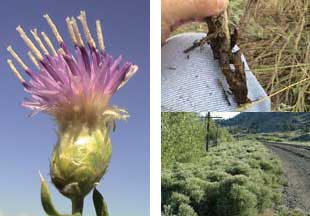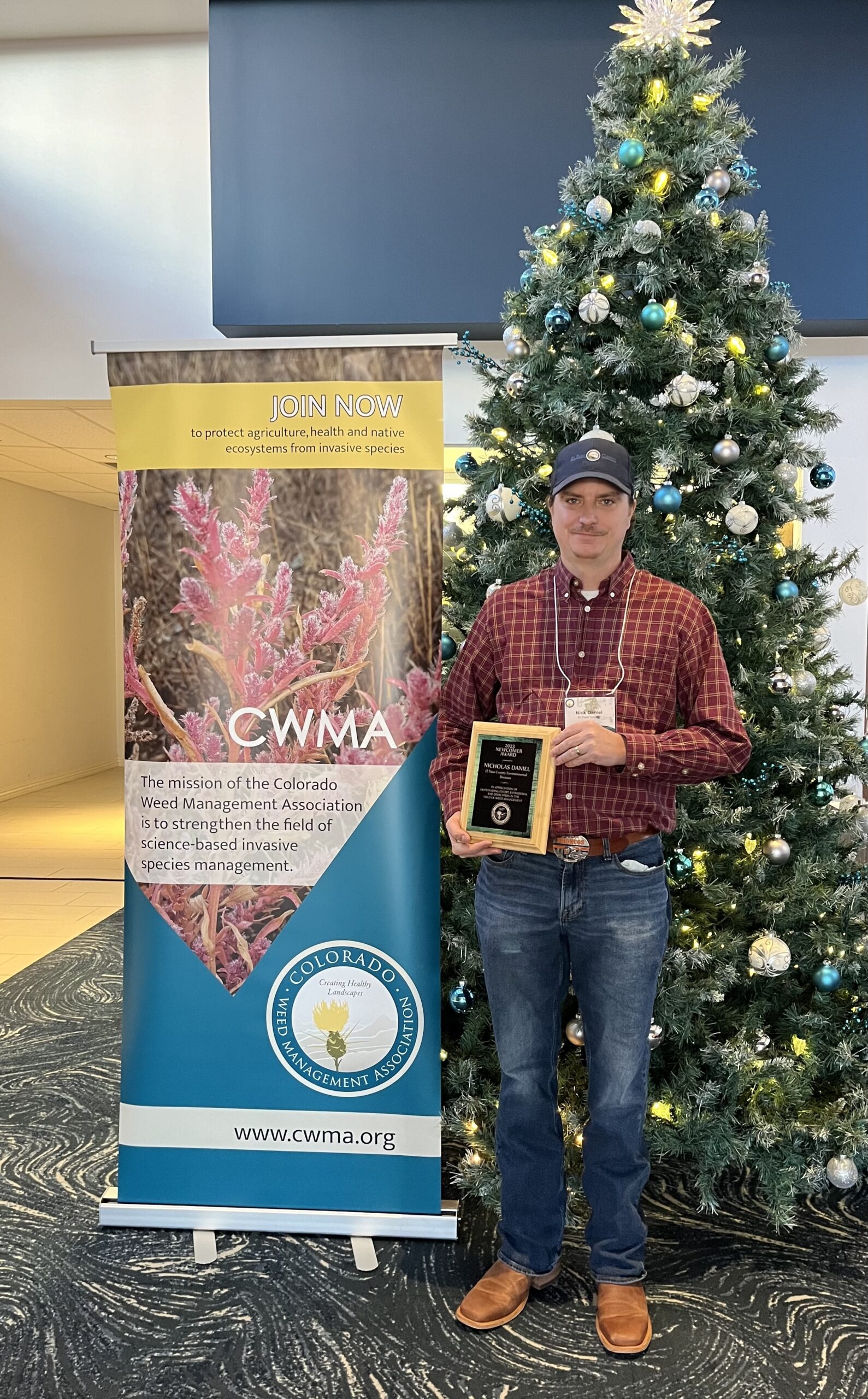Russian knapweed
Rhaponticum repens
Keys to Identification
- Russian knapweed can be distinguished from other knapweeds by the pointed papery tips of the floral bracts.
This information courtesy of the Colorado Natural Areas Program
Family
Sunflower (Asteraceae)
Other Names
Turkestan thistle, mountain bluet, creeping knapweed.
USDA Code
ACRE3, CERE6
Legal Status
Colorado Noxious Weed List B
Identification
Lifecycle
Perennial
Growth form
Forb
Flower
The flower heads of Russian knapweed are urn-shaped, solitary, and composed of disk flowers only (Zimmerman 1996). Floral bracts are broad, oval, entire, and greenish at the base with papery, finely hairy edges. Flowers are numerous, all tubular. The petals are pink or purple, turning straw colored at maturity.
Seeds/Fruit
Seeds are oval and compressed. Seeds are grayish or ivory, with long white bristles (pappus) at the tip when young, but these fall from the seed as it matures.
Leaves
Leaves are alternate. Lower stem leaves are narrowly oblong to lance-shaped, and deeply lobed. The upper leaves are oblong, toothed, and become progressively smaller. Rosette leaves are lance-shaped, tapering at both ends with the broadest part at the tip.
Stems
Mature plants are between 18-36 in tall. The stems are erect, thin, stiff, branched, and when young are covered with soft, short, gray hair (Zimmerman 1996).
Roots
Russian knapweed has a well-developed root system, which functions as the major means of propagation and spreading. The roots are easily recognizable by their black or dark brown color and presence of small alternately arranged, scale leaves, which support buds in their axils (Zimmerman 1996).
Seedling
The cotyledons (seed leaves) are oval. The first true leaves are alternate, and lanceolate with shallow toothed or smooth edges. The surface of the leaves looks grayish-green, but is not hairy.
Similar Species
Exotics
Russian knapweed can be distinguished from other knapweeds by the pointed papery tips of the floral bracts.
Natives
None known.
Impacts
Agricultural
Invades cropland and orchards. Poisonous to horses.
Ecological
Russian knapweed forms dense colonies that displace native species and reduce forage production (Whitson 1999). Russian knapweed does not establish readily in healthy, natural habitats. It typically invades disturbed areas, forming dense single-species stands. Once established, Russian knapweed uses a combination of adventitious shoots and allelopathic chemicals to spread outward into previously undisturbed areas. The plant extends radially in all directions and can cover an area of 39 feet within two years (Watson 1980). Russian knapweed contains an allelopathic polyacetylene compound, which inhibits the growth of competing plants (Watson 1980). Tests conducted with alfalfa (Medicago sativa), barnyard grass (Echinochloa crus-galli), and red millet (Panicum miliaceum) indicated Russian knapweed effectively inhibits root length elongation of grasses as well as broad-leaved plants by 30% when the polyacetylene compound is at a soil concentration of 4 parts per million (Stevens 1986). This allelopathic effect, combined with dense vegetative reproduction, allows for Russian knapweed to quickly colonize and dominate new sites.
Habitat and Distribution
General requirements
Russian knapweed can commonly be found along roadsides, riverbanks, irrigation ditches, pastures, waste places, clearcuts, and croplands, especially in areas of high water tables. It is not restricted to any particular soil but does especially well in clay soil. Watson (1980) observed that Russian knapweed infestations increased in dry locations but decreased in moist locations due to competition with perennial grasses.
Distribution
Russian knapweed is found throughout the western United States. In Colorado, Russian knapweed is widespread in the southwest portion of the state, with scattered infestations elsewhere on both the east and west slopes.
Historical
Russian knapweed is native to Eurasia, and was probably introduced to North America as a contaminant in crop seed.
Biology/Ecology
Life cycle
Russian knapweed spreads by creeping horizontal roots and seed. Shoots emerge early in spring shortly after soil temperatures remain above freezing. All shoot development originates from root-borne stem buds (Watson 1980). These buds arise adventitiously at irregular intervals along the horizontal roots. Plants form rosettes and bolt in late May to mid-June. Russian knapweed flowers from June to October (Zimmerman 1996). It does not appear to reproduce extensively from seed.
Mode of reproduction
Russian knapweed reproduces primarily vegetatively. The root system consists of the original root (taproot), one to many horizontal roots, and their vertical extensions. Buds on the horizontal roots can form adventitious shoots that may grow to be independent plants.
Seed production
A single plant may produce 1,200 seeds per year.
Seed bank
Seeds may remain viable for 2-8 years (Carpenter and Murray 1998)
Dispersal
Knapweed seeds are often spread in hay and on vehicle undercarriages.
References
Beck, G.K. 1996. Natural resources series, Russian knapweed. Colorado State University Cooperative Extension. Internet: 05/05/98. Available: http://ozma.jefferson.co.us/dpt/openspac/weed/rusknap.htm
Benz, L.J., K.G. Beck, T.D. Whitson and D.W. Koch. 1999. Reclaiming Russian knapweed infested rangeland. Journal of Range Management 52:351-356.
Carpenter, A.T. and T.A. Murray. 1998. Element stewardship abstract for Acroptilon repens. The Nature Conservancy. Internet 1/19/99. Available: http://tncweeds.ucdavis.edu/esadocs.html
Duncan, C.L. 1994. Knapweed. Cooperative extension. Washington State University, U.S. Department of Agriculture and Washington Counties. Volume 8, No. 3.
Maddox, D.M., A. Mayfield, and N.H. Poritz. 1985. Distribution of yellow starthistle (Centaurea solstitialis) and Russian knapweed (Centaurea repens). Weed Science 33:315-327.
Rees, N.E., P.C. Quimby Jr., G.L. Piper, E.M. Coombs, C.E. Turner, N.R. Spencer, and L.V. Knutson (editors). 1996. Biological control of weeds in the west. Western Society of Weed Science in cooperation with USDA Agricultural Research Service, Montana Department of Agriculture, and Montana State University.
Stevens, K.L. 1986. Allelopathic polyacetylenes from Centaurea repens (Russian knapweed). Journal of Chemical Ecology 12:1205-1211.
Watson, A.K. 1980. The biology of Canadian weeds. 43. Acroptilon (Centaurea) repens (L.) DC. Canadian Journal of Plant Science 60:993-1004.
Whitson, T.D. 1999. Russian Knapweed. In: Biology and management of noxious rangeland weeds. Oregon State University Press, Corvallis, Oregon. pg. 315-322.
Zimmerman, J.A.C.. 1996. Ecology and distribution of Acroptilon repens (L.) DC., Asteraceae. USGS Biological Resources Division, Colorado Plateau Field Station-Flagstaff, Arizona. Internet 01/20/98. Available:http://www.nbs.nau.edu/FNF/Vegetation/Exotics/Acroptilon/Russianknapweed.html


